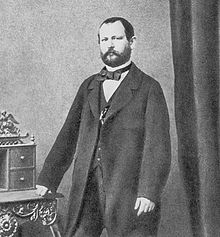Gustav Fabergé
Peter Gustav Fabergé ( Russian Петер Густав Фаберже ; born February 6 jul. / 18th February 1814 greg. In Parnu , † around 1900 in Dresden ) was a Russian goldsmith and jeweler .
Life
Origin and family
Gustav Fabergé came from a Picardy - Huguenot , later German-Baltic family. His parents were the master carpenter from Schwedt , Peter Fabergé and Maria Lovisa, née Elsner. He married the daughter of a Danish painter , Charlotte Jungstedt. The sons Peter Carl (1846–1920) and Agathon (1862–1895) emerged from the marriage .
Career
Fabergé became an apprentice to Andreas Ferdinand Spiegel from Reval in St. Petersburg , later a journeyman with Wilhelm Keibel and finally in 1841 master of the foreign guild of gold and silversmiths. He opened his own workshop in 1842, which gained a very good reputation. In 1857 Fabergé hired August Holmström as chief jeweler . In 1860 the family moved to Dresden. During this time, Fabergé's friend and colleague H. Pedin continued his jewelry business in St. Petersburg. In Dresden, Fabergé was represented in the shop of the Russian jeweler Zaiontkowski until his son took over the business. In 1870 they returned to Saint Petersburg, where Peter Carl Fabergé took over the family's jewelry business in 1872 and led to great fame and economic success as the imperial purveyor to the court .
Web links
- Fabergé Museum
- Baltic Historical Commission (ed.): Entry on Gustav Fabergé. In: BBLD - Baltic Biographical Lexicon digital
| personal data | |
|---|---|
| SURNAME | Faberge, Gustav |
| ALTERNATIVE NAMES | Fabergé, Peter Gustav (full name); Фаберже, Петер Густав (Russian) |
| BRIEF DESCRIPTION | Russian goldsmith and jeweler |
| DATE OF BIRTH | February 18, 1814 |
| PLACE OF BIRTH | Pernau |
| DATE OF DEATH | around 1900 |
| Place of death | Dresden |


